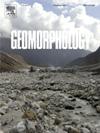Reorganization of the drainage network based on morphostructural controls in passive margins
IF 3.1
2区 地球科学
Q2 GEOGRAPHY, PHYSICAL
引用次数: 0
Abstract
The reorganization of drainage network and divide migration are fundamental to assessing the influence of tectonics, lithology, climate, base-level changes, and erosional processes on fluvial landscape evolution. However, most studies focus on tectonically active regions, leaving gaps in the understanding of these processes in intraplate settings. In South America, drainage reorganization along passive margin escarpments that drain inland under humid conditions remains poorly explored. The lack of comparative analyses between Neoproterozoic mobile belts and cratons in tectonically quiescent areas highlights the need for a comprehensive approach. In this context, this study investigates the evolution of drainage network and divide migration in a diverse morphostructural setting, considering tectonic legacies in intraplate zones. Using the Upper and Middle Grande River basin in Brazil as a study area, we applied classic morphometric parameters, identified knickpoints, analyzed longitudinal profiles, calculated normalized steepness index (ksn), and assessed drainage divide stability using the χ index. The results indicate that drainage reorganization and topographic rejuvenation are common in tectonically quiescent regions of the Brazilian Atlantic margin due to morphostructural controls and tectonic reactivations. Drainage networks of sub-basins within mobile belts exhibit greater instability than those in cratonic areas. Substrate resistance plays a key role in differential erosion and influences knickpoint formation and distribution. Although the knickpoints of resistant rocks slow down the propagation of erosional waves, differential lithologic resistance, layer inclination, and thickness result in varying degrees of persistence and long-term transient instabilities. These conditions drive river captures, drainage divide rejuvenation, and adjustments in erosional-depositional patterns.
求助全文
约1分钟内获得全文
求助全文
来源期刊

Geomorphology
地学-地球科学综合
CiteScore
8.00
自引率
10.30%
发文量
309
审稿时长
3.4 months
期刊介绍:
Our journal''s scope includes geomorphic themes of: tectonics and regional structure; glacial processes and landforms; fluvial sequences, Quaternary environmental change and dating; fluvial processes and landforms; mass movement, slopes and periglacial processes; hillslopes and soil erosion; weathering, karst and soils; aeolian processes and landforms, coastal dunes and arid environments; coastal and marine processes, estuaries and lakes; modelling, theoretical and quantitative geomorphology; DEM, GIS and remote sensing methods and applications; hazards, applied and planetary geomorphology; and volcanics.
 求助内容:
求助内容: 应助结果提醒方式:
应助结果提醒方式:


